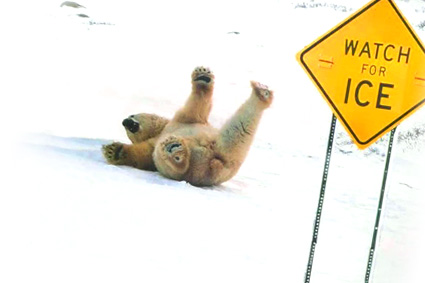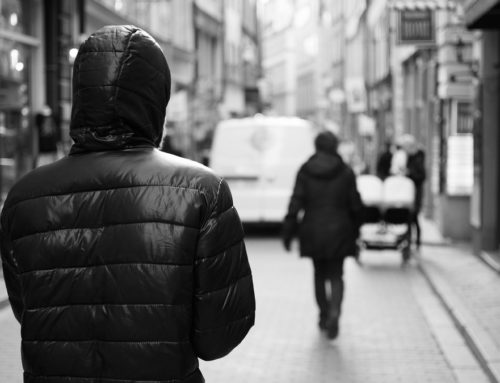Winter is in full blast! The cold temperatures and severe weather have already hit most of our area and will likely be sticking around for awhile. Although many of us may prefer staying warm inside, sipping on hot cocoa, in front of a fireplace until Spring arrives, unfortunately we can’t go into complete hibernation mode for the next few months. This means you probably will have to navigate in dangerous weather at some point soon.
The reality is as harsh as sub zero temps. The fact is, slip and fall accidents are one of the most common types of personal injury cases. Accidents can occur anywhere and at any time. Icy, snowy surfaces on sidewalks, walkways, outdoor steps and parking lots can be very hazardous for pedestrians. Inclement weather increases the chances of a slip and fall situation, resulting in possible injuries. Common injuries from slip and fall accidents include: broken or fractured bones, spinal cord injury, head trauma and brain damage, back injury, and bruises, cuts, lacerations and even death. These accidents can occur because of negligent maintenance or supervision of such property. Unfortunately, in many instances, the property manager or owner should have been aware of (or even was aware of) the potential danger, but they failed to do what was necessary to eliminate any potential threat.
As many of us have experienced, walking on snow or ice when it’s freezing cold can be a challenging task and we may wonder why the heck we didn’t just wear a pair of ice skates instead. Many people suffer and endure serious injuries every year because they lose their footing and traction in icy or snowy conditions. Check out some of the frigid statistics. The Centers for Disease Control and Prevention reports that about 1 million Americans are injured and 17,000 people die, as a result of slip and fall injuries every year. According to one study, slip and fall injury rates increase significantly as temperatures nose dive, with most injuries resulting from contact with outside surfaces.
Under premises liability law, property owners have a legal duty of care (obligation) to keep their premises safe and hazard-free. This includes keeping walkways, driveways, parking lots, and other common areas clear of ice and snow.
Although there is a legal responsibility outside of your own, first let’s hit on some precautions that you can take to help eliminate potential slips, trips, and falls and lower the likelihood of getting injured.
- If possible avoid wet, snowy, slippery surfaces. This can be tricky because these conditions are not always completely obvious, as in situations involving black ice.
- Sport the proper footwear and gear. Winter weather is treacherous but a pair of insulated, water resistant kicks with good treads can help.
- Walk slower and take shorter steps. If necessary, this will allow you to react quicker and safer.
As we’ve mentioned, you do have the right to expect to get around with reasonable safety even in the winter months. In fact, in July 2010, the law regarding accidents on snow and ice changed significantly in Massachusetts, increasing responsibility for those who cause accidents.
What does that mean for you? Property owners are now responsible for removing both “natural” and “unnatural” accumulations of ice and snow, and keeping their property reasonably safe during the winter. Prior to 2010, the state required plaintiffs seeking damages for snow and ice to make the distinction between “natural” versus “unnatural” accumulations of these substances. Massachusetts law stated that property owners couldn’t be liable for injuries that were caused by “natural” accumulations of ice or snow on the owner’s property. Basically, “natural” accumulation meant “untouched” snow and ice. Property owners who hadn’t shoveled the ice and snow from their property couldn’t be held liable. Property owners could only be held liable if they acted in some way to create an “unnatural” accumulation of these substances. For examples an “unnatural” accumulation is ice formed from a dripping, defective roof and gutters leaking onto sidewalks. For years, Massachusetts was the only state that followed this standard, which is why it was called the “Massachusetts Rule.”
Turns out, the courts had difficulty determining what was “natural” and what was “unnatural,” which was problematic. So in July 2010, The Massachusetts Supreme Judicial Court changed the common law with its ruling in Papadopoulos v. Target Corp. Justices ruled the standard for ice and snow injury liability would be the same as for any other personal injury claim. Meaning the property owner has to use reasonable care to maintain the property so it’s in reasonably safe conditions. Now Massachusetts has the same rules for snow as most other states and property owners are liable for injuries that are due to their failure to maintain their premises in a reasonably safe condition.
The ruling was significant in achieving more successful personal injury lawsuits in snow and ice slip-and-fall cases and also because it can help prevent them. Property owners must be more proactive and are no longer protected from liability by “doing nothing”. The question of what is reasonably safe is a question that may ultimately be decided by a jury. Property owners must exercise reasonable care removing snow and ice, check the property regularly, abide by any community ordinances regarding snow removal and they may also be liable if a third party moved the snow or handled it without care.
What should you do if you’ve been injured by a fall in snow or ice?
- Get appropriate medical treatment. As we discussed, injuries resulting from slippery conditions can be severe and painful. Don’t take any chances and get yourself checked out by a doctor or emergency room as soon as possible. Be sure to tell them that you were injured in a slip and fall and provide the details to directly link the injury with the fall.
- Take pictures and video as soon as possible after the fall to most accurately document the scene. Remember, weather conditions quickly change. Evidence may get moved so act fast or have someone help you capture the scene of the accident. Photographic evidence can be crucial in proving your case.
- Obtain any witness statements, if available; a witness testimony can give more credibility to your case.
- Call Schulze Law! You have a right to compensation for your damages and our experienced team can help you get through the complexities of an injury claim so you can focus on healing. Under Massachusetts law, the property owner must be notified of the accident within 30 days. We can help ensure your right to bring a claim is handled in a timely manner.
Sadly, slip and falls on icy, snowy sidewalks or steps are common especially this time of year. Slick and slippery surfaces covered with ice, snow and freezing rain make walking and navigating on them extremely dangerous. If you slipped on ice in a parking lot, sidewalk or anywhere else, discuss your situation with the experienced team at Schulze Law.
If you have been involved in a slip and fall accident and are injured, contact Schulze Law today. It is our goal that you are fairly compensated for any injuries you have sustained. We understand the intricacies of snow and ice slip and fall cases, and we have the experience, expertise and resources to help our clients.
CALL NOW: 857-300-5300 Emergency After Hours Number: 800-894-9267 XLAW1 (5291)






